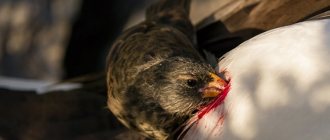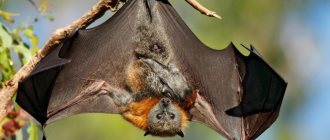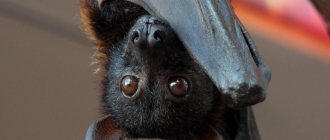Bats are amazing animals that look quite sinister and traditionally cause hostility in people. However, the fear of these cute animals that we experience thanks to horror movie scriptwriters is not justified.
According to scientists, bats have been on this planet much longer than us - they even managed to catch dinosaurs.
Although there are indeed species of bats that feed on blood, most bats are absolutely harmless to humans. Moreover, some people keep bats as pets because these creatures are very social and love the attention of their owners. When the owner of the animal leaves somewhere, the bat languishes without communication and may even die of melancholy.
Our selection includes the most beautiful bats in the world. Yes, some of them look strange and scary - and this is the aesthetics of the disgusting in its purest form.
California leaf-nosed bat
You can meet these amazing creatures in the warm deserts of Mexico and the USA. California leaf-nosed bats are harmless and do not drink blood - they prefer to feed on grasshoppers, butterflies and moths.
These babies weigh from twelve to twenty grams and have a body length of about six centimeters. The wingspan of the Californian leaf bat can reach thirty centimeters. They have funny long ears and a soft brown coat.
White leaf-nosed bat
Very cute tiny bats. The body length of the white leaf-nosed insect does not exceed three centimeters.
They live in heliconia leaves, from which bats construct tents in the shape of an inverted boat. White leaf-nosed bats live in small groups consisting of males and females. However, when females have offspring, leaf-nosed insects change their way of life - several males with offspring live with one harem male, who guards their home.
Features of behavior
Animals lead a secretive lifestyle in the remote corners of the jungle. Bats fly out to hunt at dusk and dawn in flocks of 4-5 individuals. Like most bats, they are nocturnal and sleep during the day in the depths of caves. The average size of the colony is 100 individuals.
Bumblebee mice communicate using sound signals. A high-frequency squeak, which is not perceived by the human ear, helps these animals not only maintain communication, but also navigate in space.
However, scientists cannot yet understand whether there is a hierarchy in the group of small bats, and how individuals build relationships with each other.
Brown long-eared bat
This is a small funny animal - most likely, when you see a brown long-eared bat, you will experience not horror, but tenderness. Its main advantage is its huge ears, which can be longer than the entire length of the animal’s body. Naturally, it is not easy to be the owner of such luxury - bats have to hide their ears under their wings or tilt them back when resting.
Brown long-eared monkeys can also be found in Russian forests, but in our country their numbers are not so large. These cute creatures are most common in Iran, Palestine and Portugal.
What class of animals does a bat belong to?
A unique and at the same time terrifying creation of nature is the bat. The animal belongs to the class of chiropteran mammals. The exemplary behavior of parents will make anyone who sees the mother’s care touch. The female is capable of raising someone else's child if necessary. Zoologists call flyers altruists.
Microchiroptera became special for many reasons:
- high sensitivity to light, ultrasound;
- the only mammals that can fly;
- in the dark they reach speeds of more than 45 km/h;
- have a special way of orientation at night.
Scientists have been arguing for a long time about the identity of the bat. The creature has characteristics of both animals and birds.
Large fruit-eating leaf-nosed insect
The appearance of these animals may seem quite frightening, but their unique beauty lies in this awkwardness. These bats live in Central and South America. The body of a large fruit-eating leaf-nosed insect is covered with short, smooth brown fur. The muzzle is decorated with two light stripes.
As you may have guessed, this type of bat eats fruits - so you should not be afraid of them.
Interesting Facts
Due to its tiny size, this animal is also called the bumblebee mouse. Indeed, its length and weight are comparable to that of an insect. And many arthropods significantly exceed this creature in size.
Its light weight and strong wings allow the animal to hover in place like a hummingbird. Having stopped in the air, she is able to remove an insect from a branch without landing on it. Perhaps this ability helps the animal not to scare other insects lurking nearby.
Thai zoologist Kitty Thonglonya, who first described this species, died suddenly shortly after her discovery. Colleague John Hill, who worked in the jungle with the scientist, decided to perpetuate his memory in the scientific name of the species and entered it into the database as Craseonycteris thonglongyai.
Red hairtail
These amazing creatures help our ecosystem. The fact is that farmers in North America partly owe their harvest to red hairy tails, which destroy a huge number of insects.
These animals ended up in our selection due to their fiery red fur. Red hairy tails are very small, and therefore are unlikely to scare anyone, despite their terrifying appearance.
Typically, bats give birth to only one pup - but female red hairy bats can carry up to four pups.
Gray hairtail
Gray hairtails are fast and agile hunters. An hour after sunset they begin to catch insects, and, it must be said, they extremely rarely fail.
These are small animals with a body length of about 26 cm and a weight of 14 to 26 grams. They have short but very thick fur of a pleasant gray shade. You can meet these amazing creatures in North and South America.
Ushan
The name says it all: these mice have large locator ears. When the animals sleep, they hide them under their wings. The wings are short and wide, thanks to which the animal flutters and can even hover for a short time. The sizes are small – 5-6 cm.
The habitat is extensive: from the Atlantic coast to the Pacific, northern Asian territories, North Africa. The diet consists of butterflies, mosquitoes, beetles and other nocturnal insects. The offspring is 1, less often 2 cubs per year.
Hammerhead fruit bat
These are huge bats with a very specific appearance. Their body length can reach as much as 28 centimeters!
Hammerhead fruit bats live in the tropical forests of Africa. These strange animals are often called “flying dogs” - their muzzle actually vaguely resembles a dog’s.
Hammerhead fruit bats feed exclusively on fruits - so if you do come across this incredible animal, you don’t have to be afraid of it.
Ushan Townsend
The main distinguishing feature of Townsend earflaps is their very long, flexible ears. This is a small animal whose body length rarely exceeds 10 centimeters.
These bats prefer to hide in abandoned buildings, mines and caves.
They feed on moths and other small insects. Townsend's long-eared cats are skilled, dexterous hunters, capable of performing incredible tricks in the air.
What is a bat?
Bats belong to the order Chiroptera. This means that both forelimbs are turned into large wings , with highly elongated fingers serving as a frame for them.
This structure does not allow them to soar like birds, forcing them to constantly flap their wings.
The flight speed of bats can vary from 15 km/h when simply moving, to 60 km/h when catching insects.
Another distinctive feature of these animals is the way they land . In a short period of time, bats need to slow down and sit head down on a horizontal surface. They do not create nests .
REFERENCE! They feed on the fly, catching various insects right in the air. Typically, one animal can catch up to 200 mosquitoes in an hour.
You can find out more about what bats eat here.
Yellow-winged false vampire
This animal has amazingly beautiful yellow-red wings and ears. The rest of the body may be mousy or blue-gray. The yellow-winged false vampire has a very large funny nose, which makes his appearance truly memorable.
These animals are quite common in Africa. They feed exclusively on insects and pose no threat to humans.
Hairy Vampire
Perhaps the most dangerous bats in our selection. They live in Central and South America, and you really need to beware of them - they are adapted to human blood and can feed on it.
This is one of the three existing types of real vampires. It is because of them that other bats do not have the best reputation. It was previously believed that bushy-footed vampires could feed exclusively on the blood of wild birds, but recent research has refuted this.
Distribution and habitat[edit]
Pygmy little fruit bats are found in much of northern South America east of the Andes, from northern Bolivia, through eastern Peru and Ecuador, through northeastern and Amazonian Brazil, and into southern Colombia and Venezuela, and throughout Guiana. [1] They are widespread and usually present in large numbers where they occur, preferring virgin forests below 1,400 m (4,600 ft) but are also occasionally found in more disturbed habitats, including plantations and grasslands, as well as open savannas. [3] [4]
Subspecies not recognized.
Banana Leaf Beetle
These unique creatures come from Mexico. They prefer to live in trees, caves or on the surface of rocks.
Their main distinguishing feature is their long tubular muzzle. They were given such a non-standard appearance because banana leaf-noses feed exclusively on fruit nectar. These little bats do a lot for our ecological system by helping to pollinate plants.
White casetail
A very cute creature with a funny face. White casetails are able to express their emotions through facial expressions, which makes them even more interesting creatures.
White casetails can be seen in tropical forests from Mexico to Brazil, as well as on the islands of the Caribbean.
This species is distinguished by soft, long and pleasant to the touch white fur. Large eyes and tiny yellowish ears make white casetails very cute animals.
Skeleton and wings
The structure of the skeleton resembles that of a small bird. Limbs with five fingers, modified. The claws are sharp and large. The skeleton consists of:
- spine: 3 times shorter than wings;
- limbs: underdeveloped, since the humerus is shortened;
- skull: rounded (front part, depending on the type, shortened or elongated);
- a small tail section that serves as a rudder (with its help the animal maneuvers during flight).
Philippine tubenosed fruit bat
The Philippine tubenosed fruit bat can lay claim to the title of the best hide-and-seek player on the planet - the first individual of this species was discovered only in 1984. It is unfortunate to admit that today these amazing creatures are in danger of complete extinction due to uncontrolled deforestation of rain forests in the Philippines. It is vital for this species to settle in dense and healthy forests. We can only hope that these creatures will not lose their homes due to human whims.
Like many other species of bats, Philippine fruit bats play an important role in our ecosystem by dispersing the seeds of the fruits they eat.
Appearance
The bat looks quite terrifying. However, like fruit bats. The distinctive features of the two suborders are:
- The fruit bat menu consists of vegetables, fruits, and nectar. Microchiroptera feed on insects, reptiles, small mammals, and fish.
- Short muzzle, smaller size
- Fruit bats have two claws on their fingers. The tragus-outgrowth is absent.
- Only the second squad has a sophisticated echolocation system.
Interesting fact! The diversity of species forms does not allow us to determine external similarities and differences between families of bats. The smallest representative weighs 2 g, and the largest are: the bare-skinned bulldog and the false vampire from Southeast Asia, each weighing 175 g.
Indian flying fox
One of the largest species of bats. The wingspan of the Indian flying fox can reach 130 cm, and its weight exceeds 1300 grams.
The structure of the muzzle of these bats resembles that of a dog, which is probably why they do not seem frightening to us at all, despite their impressive size.
Flying foxes love to feast on fruits, which is why they cause indignation among farmers in the Indian subcontinent. People spray fruits with toxic substances, which negatively affects both the number of flying foxes and the health of fruit consumers.
Drones in global war: RQ-180 or “White Bat”
For quite a long time after the end of the Cold War, the government of the United States of America delayed funding defense projects aimed at confronting a high-tech enemy.
These words should not be misinterpreted - they do not mean that the US military was not prepared for large-scale clashes with a well-equipped enemy army. The point is that the advantages received by the United States during global modernization (associated, in particular, with the process of the so-called “digital revolution”) of its army in the 80s of the last century were gradually leveled out, and the edge of technological superiority was increasingly and became more blurry.
To a large extent, these financial restrictions also applied to drones.
Despite their obvious value (particularly in the eyes of the military), the US Air Force had difficulty obtaining funds for projects not related to the development of weapons for local conflicts alone. According to civilian officials, the armed forces already had a large and modern fleet of manned aircraft - and heavy drones were redundant.
Perhaps the most remarkable breakthrough of Pentagon military administrators was obtaining funding for the RQ-4 Global Hawk strategic reconnaissance UAV project. The remaining projects were cut down - only those that were critically needed by the American army on the battlefield “survived” - such as, for example, the legendary RQ-1 Predator or its successor - the RQ-9 Reaper.
But by the end of the 2000s, the situation in the world began to change rapidly: Russia and China began actively modernizing their armed forces, including significantly expanding the capabilities of their own air defense. First of all, this seriously affected the strategic and operational intelligence capabilities of the US Air Force.
New conditions required a response at a qualitatively different level - and thus the project, now known as “White Bat,” was born.
It is worth noting that development programs for unmanned reconnaissance aircraft using stealth technology did not appear out of nowhere, and were conceptually formed back in the 1990s.
The American military was already prepared for the threat from, say, China at that time. For example, the commander of naval operations, Admiral Frank B. Kelso II, in the first half of the decade, repeatedly emphasized in his memos and doctrinal documents the need to prepare for confrontation with the PRC.
However, as mentioned above, with the collapse of the USSR, US civil authorities seriously tied the hands of Pentagon officials - all development of new drones was carried out almost on an initiative basis in absolute secrecy and received funding from the so-called. the secret budget of the US Air Force, as well as the CIA (in general, the Central Intelligence Agency, with its high degree of independence from the civilian government apparatus, literally saved stealth drones: it was thanks to the CIA that both the RQ-170 Sentinel and the RQ-180 were embodied in metal).
The colossal scientific and technical groundwork for the stealthy F-117 and B-2 aircraft, as well as extensive experience in the practical use of UAVs, allowed the Americans to implement strategic reconnaissance drone projects in the shortest possible time (less than 10 years, but possibly less).
RQ-170 Sentinel
The first was the infamous RQ-170 Sentinel - although the exact time of the appearance of these devices is still unknown, approximately this drone began to be used on a limited basis by the US Air Force and the CIA in 2005.
Sentinel, apparently, was initially considered as a transitional link to a more functional stealth reconnaissance aircraft - this model was intended to test the concept of a drone capable of operating over the territories of countries with developed and rich air defense. Unfortunately, there are no specific details of the operation of the RQ-170 in the public domain, but over the years the Pentagon has shed light on some interesting points: UAVs regularly flew over the DPRK, some regions of the PRC, Pakistan (in particular, it was the RQ-170 that conducted surveillance behind the hideout of Osama bin Laden), as well as Iran (during which one device crashed near Tehran due to a technical malfunction).
In particular, it is reliably known that the 30th reconnaissance squadron of the US Air Force online monitored the preparation and launch of the Hwasong-14 intercontinental ballistic missile produced by the DPRK in 2022. As you might guess, the launch pad is an object of strategic importance and was covered by North Korean air defense, but nevertheless the RQ-170 Sentinel completed its task of penetrating the so-called. "prohibited zone".
However, the design features of the RQ-170 imposed a number of restrictions on its ability to penetrate areas protected by the most modern air defense systems. Sentinel had some design elements used in earlier stealth systems, but could not be considered completely stealthy.
In addition, the drone that crashed near Tehran was examined by Russian and Iranian engineers - this finally put an end to the further development of the project (according to some reports, the crashed RQ-170 served as the impetus for the creation of the Russian S-70 “Okhotnik”).
In 2008, new buildings appeared at the Northrop Grumman plants in Palmdale and Tonopah, as well as at the legendary “Area 51” located on the dry Groom Lake in Nevada - aircraft hangars, which, according to satellite imagery, could accommodate an aircraft with a wingspan of 40 meters. This was not an accident - the buildings were erected specifically for the new strategic reconnaissance aircraft RQ-180, whose prototypes entered the flight testing stage.
"White Bat"
“White Bat” is a conceptual and technical successor to the line of the legendary “stealth” F-117 and B-2, which were created to operate in conditions of opposition from the echeloned and dense air defense of the Warsaw Pact countries.
The RQ-180 was designed for similar tasks, but adjusted for a qualitatively new level of development of Chinese and Russian counter-aircraft systems.
The White Bat is not a strike machine - its central task is reconnaissance. This UAV is intended not only to complement the capabilities of optical satellites, but also to replace them in the event of an attack on the US satellite constellation as a tool for collecting intelligence data at the operational-tactical level.
In addition, the functionality of the RQ-180 is closely related to the Long Range Strike Bomber program: operating in conjunction with the stealthy B-21 Raider intercontinental bomber, the White Bat, being undetected, will invade the so-called. “denied access zones A2/D2” and issue target designations to missile carriers (not only bombers, but also fifth-generation F-35 aircraft or guided missile ships).
Among other things, the RQ-180 is by default also considered as an electronic warfare platform - each drone is armed with the means to conduct electronic attacks.
It is worth mentioning the prospects for using the “White Bat” as an AWACS vehicle - according to the assumptions of many military theorists, classic long-range radar reconnaissance aircraft in the event of hostilities will not be able to actively operate near the A2/D2 zones.
As an alternative, they are encouraged to use stealth platforms that can penetrate directly into enemy territory - such as the RQ-180, which can "hack" restricted areas with stealth bombers and stealth interceptors created in currently under the Penetrating Counter-Air program.
The RQ-180 is a completely classified project, like all other “stealth” aircraft (including older models represented by the B-2 and F-117), and yet information periodically appears about its flights in one point or another on the globe.
Most often, it is confirmed, albeit not immediately, by representatives of the US Air Force themselves or by think tanks associated with them.
According to the data, as of 2022, the US military had seven White Bats, which were deployed in a number of reconnaissance operations in the Pacific Ocean, the Korean Peninsula and even in the skies over the Syrian Arab Republic and China.
American military analysts suggest that the RQ-180 is already ready to implement the “stealth long-range strike” doctrine in conjunction with the B-2 stealth bombers in service with the US Air Force. This dangerous tandem is directed towards China - “White bats” were spotted (visually) in the area of the Philippines and the island of Guam.
However, the Air Force command announced that large-scale production of the RQ-180 will begin in 2026–2027 - that is, approximately the same time when the American Air Force receives the first large batches of B-21 Raider bombers and will have an impressive number of fifth-generation aircraft F-35.
Special emphasis should be placed on the White Bat control system - given that it is being developed by Northrop Grumman, which is simultaneously creating the latest software for existing UAVs in order to increase their autonomy, we can assume that the RQ-180 will be either completely independent of the operator (in particular, when penetrating into zones A2/D2, where the communication channel between the pilot and the device can serve as an unmasking factor), or external control of the drone will be a common formality - say, the machine itself will identify and select targets, and the operator will only confirm her choice.
Most likely, the initial design of this vehicle included the ability to fly completely independently and perform reconnaissance missions.
The RQ-180 is definitely one of the most interesting developments of our time, and it requires special, close attention. After all, the “White Bat” was created and is being finalized to carry out missions in the areas of activity of the most advanced Russian air defense systems.











